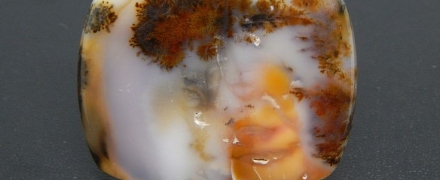open 10 am - 7 pm
laboratory is closed
Painting in stone - landscape opal

Landscape opals are opals that have mineral inclusions that form bizarre patterns that resemble a painted picture.
Such opals, with rare exceptions, are not noble. Most often, patterns are formed by inclusions of dendrites of iron and manganese hydroxides. These inclusions are syngenetic, that is, formed simultaneously with the formation of the opal itself, or develop along microcracks. Less common are other pattern-forming minerals, such as rhodusite and hematite, which were formed before the formation of opal and were captured by it during growth.
In Russia, the most common landscape opals are opals from Kazakhstan. In these stones, against a light-colored background of opal, a voluminous intricate pattern, like drawn with ink, stands out.
Landscape opals from Peru, Mexico and Australia are also found on the world jewelry market.
В геммологической практике бывают весьма увлекательные случаи с диагностикой ювелирных вставок
Но помимо редкости цвета и высокой стоимости таких камней, многие розовые камни выделяются одной замечательной особенностью – они проявляют плеохроизм, то есть в зависимости от положения осмотра камня он может иметь дополнительные оттенки – оранжевый или пурпурный.
Currently, gemstones are produced by two fundamentally different technological methods - the High Pressure - High Temperature method (“HPHT”, High-pressure & High-temperature) and the Chemical Vapor Deposition (“CVD”, Chemical vapor deposition) method. The "HPHT" method is the most tested classical synthesis method, which can be used both carbon deposition on diamond from flux melts and catalytic reactions. In "CVD" synthesis, diamond growth occurs on a seed during carbon deposition mainly from a gaseous medium at relatively low temperatures and pressures.
Jewelry and precious stones are just such a category of goods, when buying which you need to pay attention to many criteria.
Sogdianite is a rather rare mineral and more often it can be found as a collection material (moreover, in systematic collections), and it is extremely rare in jewelry.






